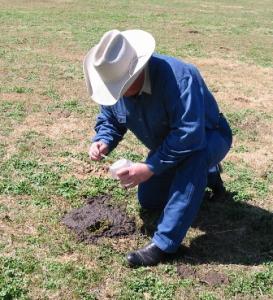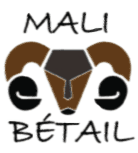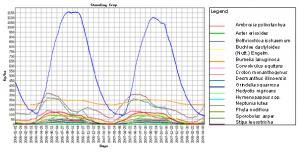
NUTBAL: Livestock nutrition balance decision support system
A decision support system that monitors animal diet nutrient concentrations for diet optimization toward producer goals
Animal nutrition-based decision making
NUTBAL’s primary purpose is to provide the livestock industry with the means to monitor the nutrient concentration in the animal’s diet and determine if the current diet is sufficient to meet performance goals set by the producer. NUTBAL is a decision support system that models the crude protein and net energy status of cattle. This computerized decision aid lets the user their herd, environmental conditions, and establish weight performance targets. This information is then coupled with results from a near-infrared reflectance spectroscopy, or NIRS fecal analysis, by scientists at the Grazingland Animal Nutrition Laboratory (GAN Lab). From this, the lab produces an animal performance report and the least-cost nutrition management plan.
NIRS/NUTBAL Reports include the following information:
- plane of nutrition
- weight gain or loss
- the nutrient most limiting animal performance
- least cost feeding solution
- amount of feed and forage consumed
Unlike many nutritional balance packages geared toward pen-fed animals, NUTBAL calculates what animals will consume ad libitum under grazing conditions. In many cases, voluntary intake of ruminants in free-ranging conditions differs from that predicted by published equations.
Applications
As part of the NIRS/NUTBAL system, NUTBAL is an effective nutritional monitoring tool designed for ranchers and other free-grazing managers. The system generates valuable information that enables the user to make informed and timely decisions regarding animal nutrition and grazing management. Private enterprise applications of the NIRS/NUTBAL system are varied and can be custom designed to meet the goals of the individual user. Most private users employ NUTBAL to assist in one or a combination of:
- Improving body condition more economically
- Managing weight loss during drought or dormant forage periods
- Maintaining desired body condition during critical periods to enhance productivity
- Enhancing effectiveness of supplement feeding by identifying when forage is inadequate, when forage quality recovers and how much feed is needed to meet goals
Various agencies and groups also use the NIRS/NUTBAL system as a research tool in developing guidelines for the public, collecting data, and facilitating environmental conservation, to name a few. Such programs include EQIP, CSP, and the Forage Quality & Animal Well-being Program.
Availability

Access to NUTBAL is available via the interactive website, NUTBAL online. The online application allows users to submit their information for NIRS analysis on a livestock fecal sample which is then mailed to the GAN Lab. Once the GAN Lab completes and records the sample’s NIR analysis, the interactive website automatically generates NUTBAL reports for the sample based on data entered by a user. The NUTBAL software is available in a metric unit of measure version as well as the English unit version.
Model Systems
The NUTBAL model uses a combination of published systems including the NRC’s 1984, 1987, 1996 basic nutrient requirements formulas, Fox et al. (1988) adjustments to the NRC equations, McCollum’s rumen degradable protein thresholds and DOM/CP ratio concepts and Moore and Kunkel’s concept of intake change rate and deviation of metabolizable energy due to associative effects in growing animals. Where NUTBAL deviates from other systems is in the application of a quasi-metabolic fill system to predict dry matter intake of the animal. This approach allows modeling of fecal output processes, which consider more than just the digestion process. Other factors are derived from literature review, expert opinion and unpublished data extrapolated from prior studies. Impacts of forage availability, appetite drive, and associative effects can be characterized in both fecal output as a proportion of fat-corrected body weight and metabolizability of ingested forage.



